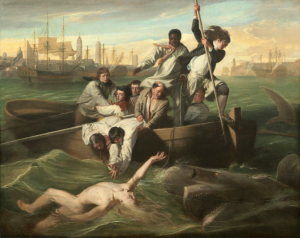Before Roy Schneider’s dazed assessment that “we’re going to need a bigger boat,” before Richard Dreyfus and Robert Shaw unbuttoned shirts and rolled up sleeves to reveal their scars after a drunken meal below decks, and before Peter Benchley scratched out the first draft of his novel “Jaws”, there was this painting. One of my favorites.

I purchased a print of it years ago when I visited the National Gallery of Art in Washignton DC. Having first seen it there, I instantly fell in love with the painting. Odd, I know, as my wife would be the first to point out. Nevertheless, I’ve been fascinated by this work ever since.
Born in the British colonies of the New World, Copley painted his work in the mid-1770s in England. He released it for viewing in 1778.
The scene is his rendering of an event in the life of one of Copley’s friends, the young boy in the water, Brook Watson. He fell overboard just off the coast of Cuba, seen in the background. A shark bit off one of his legs. Watson survived to become the Lord Mayor of London. That’s where he and Copley became friends. Watson told the story to Copley and Copley placed the story on canvas.
What do you think of when you see this painting? Probably Jaws, if you’re of a particular vintage (like fine wine, you’re just getting better). But think again. Maybe you’re calling to mind the Biblical story of Jonah. Don’t look for anything worthy of regurgitation here.
For me, I’m thinking of the year and what’s going on. 1778 is the heart of the War of the American Revolution. Copley is in England while the mother country fights to hold on to its thirteen rebellious colonies in the New World. Cuba, by the way, was the scene of fighting in the previous major war in North America, the French and Indian War. Thirteen years after the bleeding, one-legged Watson is hauled back into the boat and the shark digests the human appendage in its mouth, British and British colonial forces clash against Spanish units in Havana, Cuba.
Though I don’t think Copley intended this, I can’t help but think of the boat and its crew as an allegory for British colonization in the New World. Tossed and tumbled in rough waters far from home, the crew struggles against native elements capable of chewing them to death. Prominent in the boat is the black man, a stranger like the rest of the crew, brought to these shores from another place.
Does all look lost in this painting? Can you envision the boy escaping?
It looks bleak to me. The boy seems beyond the grasp of the two men, especially in choppy waters. The great beast looks too strong for the lone, thin spear. The rope epitomizes the helplessness of everyone else. The trend of motion—the lean of the story—suggests that we’re watching the onset of a horrible death.
I suspect we all like to think or hope that we would act swiftly and courageously in an emergency. Soldiers and first-responders will say that training solidifies that hope into instinct. I suppose an explosion of adrenaline and sheer nerve can do the same thing, at least for a while. But sometimes the power of circumstances is too much, the water and wind and the brute force of the thing against us is too great.
Watson and the Shark, a painting with a story as deep as its setting.







